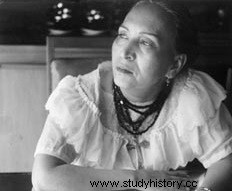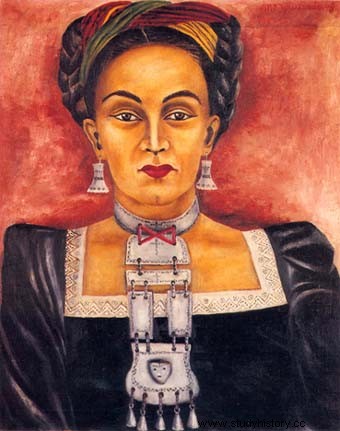María Cenobia Izquierdo Gutiérrez, known as Ma ría Izquierdo (1902 – 1955) was a Mexican painter, the first to exhibit her works outside of Mexico.
First exhibitions
 María Cenobia Izquierdo Gutiérrez was born in San Juan de los Lagos (Mexico) in 1902, although some biographers date her born in 1906. Following the death of her father, when she was five years old, she was brought up by her grandparents until her mother remarried. At the age of 14, she married Colonel Cándido Posadas in an arranged marriage. At 17, she has already carried three children.
María Cenobia Izquierdo Gutiérrez was born in San Juan de los Lagos (Mexico) in 1902, although some biographers date her born in 1906. Following the death of her father, when she was five years old, she was brought up by her grandparents until her mother remarried. At the age of 14, she married Colonel Cándido Posadas in an arranged marriage. At 17, she has already carried three children.
In the 1920s, after separating from her husband, María entered the Escuela Nacional de Bellas Artes (School of Fine Arts) and began to paint his surroundings (the Portrait of Belem in 1928, Sleeping Little Girls in 1930) then still lifes and landscapes. She was notably trained by the painter Rufino Tamayo, who had a great influence on her painting and with whom she had an affair. From her first year, she took part in four exhibitions. Her works immediately met with great success, both with the public and with her peers, especially Diego Rivera, who considered her one of the best students in the school.
International recognition
 In 1930, María Izquierdo held her first solo exhibition at the Art Center Gallery in New York. She presents fourteen oils, including portraits, landscapes and still lifes. The same year, she also exhibited some works at the Metropolitan Museum of Art (Met) in New York, alongside Rufino Tamayo and Diego Rivera. Recognition of her talent then became international and María exhibited in Paris in 1940. In May 1944, she became cultural ambassador for Mexico and traveled to South America until September.
In 1930, María Izquierdo held her first solo exhibition at the Art Center Gallery in New York. She presents fourteen oils, including portraits, landscapes and still lifes. The same year, she also exhibited some works at the Metropolitan Museum of Art (Met) in New York, alongside Rufino Tamayo and Diego Rivera. Recognition of her talent then became international and María exhibited in Paris in 1940. In May 1944, she became cultural ambassador for Mexico and traveled to South America until September.
In the mid-1940s, María suffered her first heart attack and had to put a stop to her career. However, she continued to paint until she was physically unable to do so, and died of a heart attack on December 2, 1955.
María Izquierdo is known for the rich and vivid colors of her paintings, depicting family scenes, still lifes and landscapes. Some of her themes sometimes class her as a surrealist painter, but she herself never identified as such.
